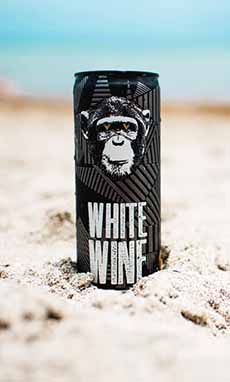TIP OF THE DAY: Wine In Cans
|
When wine in cans and boxes were first broadly available in the mid-1990s, we tried a couple and turned up our nose. At that time, we were writing about fine wine, and just didn’t find canned wines worth our focus. But American consumers flocked to canned wines. And, when “better” winemakers realized consumers liked them, they began to can some of their own wines. The result: Sales of canned wine have been meteoric. In 2016 alone, there was a 125% annual increase in canned wine sales over the previous year. While the category’s sales of $14.5 million in that period is small compared to total wine sales, it was a seven-fold bump over 2012, when canned wines were less than $2 million in sales. Two years later, in 2018, canned wine sales had doubled to $28 million. Some winemakers have since found that more than 50% of their sales can be in canned wines. Depending on producer, canned wine is sold in three sizes: First, let’s observe that you can pour the wine from a can into a glass (photo #1). Or you can drink from the can—with or without a straw (photo #2). 1. Non-Breakable: No glass bottle to break if you accidentally whack it (and what a mess to clean up). If you drink from the can, there’s no glass to break or wash. 2. Convenient: Easier and more lightweight to transport, and there’s no corkscrew required. Take cans to the beach, the barbecue, camping or just hanging out outdoors. 3. Portion Control: Limit yourself to one can. There’s no open bottle for refills. In another vein, when we just want a small amount of wine and don’t have an open bottle, we grab a can to drink indoors; or open a can when we need to add a couple of tablespoons to recipes, drinking the rest. 4. Environmentally Friendly: Aluminum is more likely to be recycled than glass. According to the EPA, only 26.4% of glass containers are recycled, whereas 54.9% of beer and soft drink cans get recycled. Aluminum weighs less to transport, which cuts down on carbon emissions and reduces the overall carbon footprint. Most of the canned wines are marketed under different names from the winery—or are wines canned by producers who just sell canned wine. As exists with wine in bottles, the company that cans/bottles and sells the wine, doesn’t make necessarily make it. They may buy ready-made wine from those who do. There are “straight” names like Brick & Mortar, Bridge Lane, Eufloria, Nomadica, omikai, Una Lou; and cheeky names that bring a smile, like Dear Mom, House Wine, The Infinite Monkey Theorem* and No Fine Print. The designs are nice, too: from charming to quirky to fun. One acclaimed vintner that’s proud to put its name on its canned wines is Bonterra, the number-one organic winery in the U.S. They grow the grapes, make the wine, bottle it, or alternatively, can it. The cans are a recent development for this Mendocino County winery, which has been making organic wines for more than 30 years. Most of the grapes they vinify are estate-grown on the vineyard’s 1,000 acres; the rest are sourced from nearby organic vineyards. We liked their canned Rosé so much that we gave the pink cans with pretty floral illustrations as Valentine gifts. In addition to the Rosé are cans of: You can easily buy them online. For those who care about sustainability, Bonterra vineyards have been farmed organically since 1987—long before organic products were widely available in the U.S. The name means “good earth.” The company is committed to organic farming and regenerative practices that enrich the biodiversity in their vineyards. Let’s hear it for canned wines. One of the reasons we didn’t list individual brands is that each store will have its own selection of canned wine brands. For fun, pick up different brands and do a tasting to see which you like best. Time for a party! |
|
|
|
________________ *The infinite monkey theorem states that a monkey hitting keys at random on a typewriter keyboard for an infinite amount of time will almost surely type any given text, such as the complete works of William Shakespeare. Here’s more about it.
|
||





